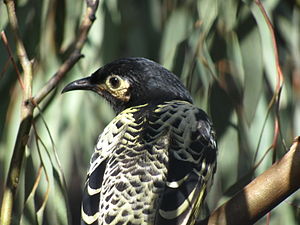Wart honeyeater
| Wart honeyeater | ||||||||||||
|---|---|---|---|---|---|---|---|---|---|---|---|---|

Wart honeyeater ( Anthochaera phrygia ) |
||||||||||||
| Systematics | ||||||||||||
|
||||||||||||
| Scientific name | ||||||||||||
| Anthochaera phrygia | ||||||||||||
| ( Shaw , 1794) |
The warts honeyeater ( Anthochaera phrygia , Syn. : Xanthomyza phrygia ) is a 25 centimeter great representative of the family of honeyeater .
Appearance
These birds have black plumage that turns yellow towards the tail. The head is black. The area around the eyes is yellow. The thin beak is gray to black. The neck is black, the chest is also black and turns yellow towards the belly. It has a yellow or white spot on the shoulders. The tail is colored black above and the underside is yellowish. The legs are grayish and pink in color. Their long tongue helps them to extract the nectar from the deep calyxes. Males and females did not differ from each other in terms of plumage color.
Distribution and way of life
This species was once widespread from Queensland , New South Wales , Victoria , South Australia and the Australian Capital Territory . They live as nomads outside of the breeding season and move in swarms through the landscape in search of water and food. The wart honey eater prefers to inhabit wet forests with eucalyptus and savannah areas near water. There they prefer to stay in the canopy of tall trees. They feed on the nectar of various flowering plants, tree species such as eucalyptus, banksias , fruit trees and honeydew or manna . They think their protein needs are due to the consumption of smaller insects. The voices of the wart honey eater are loud and very shrill. They can also be found in gardens of human settlements. The moulting takes place after the breeding season.
Reproduction
The main breeding season for this species is between September and November. They build a cup-shaped nest. During the brood they are very aggressive towards other conspecifics. If the food supply allows, they kill several broods in one season. Usually 2 and rarely up to 5 eggs are laid in the nest. The female usually takes on the breeding business alone; the male only supports it in feeding the young. The breeding season is about 14 days. At the age of 2 weeks the young leave the nest for the first time.
Hazards and protective measures
From the 1940s, the population of this species decreased rapidly. The wart honeyeater was last spotted in South Australia in 1977 . The IUCN currently classifies this species as critically endangered . The reasons are the logging, the conversion of their habitat to agriculture and competition from other species from the families of honeyeater especially from the kind of leather heads ( Philemon ). In order to protect this species, a breeding program was started in various zoological gardens in 2007.
literature
- Dominic Couzens , Simon Papps (ed.): Rare birds - survivors, evolution losers and the missing: 50 portraits. Translated from the English by Coralie Wink, Monika Niehaus . Haupt Verlag, Bern / Stuttgart / Vienna 2011, ISBN 978-3-258-07629-4 , pp. 112-115 (title of the original English edition: Atlas of rare birds. New Holland Publishers, London 2010).
- Christopher M. Perrins (Ed.): The FSVO encyclopedia birds of the world. Translated from the English by Einhard Bezzel. BLV, Munich / Vienna / Zurich 2004, ISBN 978-3-405-16682-3 , pp. 466–469 (Title of the English original edition: The New Encyclopedia Of Birds. Oxford University Press, Oxford 2003.)
- Christopher M. Perrins (ed.): The great encyclopedia of birds. Translated from the English by Christine Barthel, Peter H. Barthel. Orbis, Munich 1996, ISBN 978-3-572-00810-0 , p. 316.
Web links
- Anthochaera phrygia inthe IUCN Red List of Threatened Species 2018.2. Listed by: BirdLife International, 2018. Retrieved December 24, 2018.